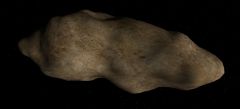1620 Geographos
1620 Geographos is a Near-Earth object discovered in 1951 by Albert George Wilson and w:Rudolph Minkowski at Palomar and is named in honor of the w:National Geographic Society.
Geographos was to be visited by the Clementine mission, but it failed to reach the body.
Geographos in Orbiter
1620 Geographos was modeled in Orbiter as a somewhat potato shaped object about 5 km on the longest dimension. Because the visual surface of Geographos is well below the hard radius of the body, landing anywhere on the body's radius you end up well above the visual surface. Because even at the surface, geographos only provides 1% of the local gravity, the Sun providing the other 99%, a ship cannot orbit Geographos, it can only fly along with it in solar orbit, maneuvering in its vicinity. A ship also cannot land and remain on the hard surface, it will immediately drift off the surface. When maneuvering in the vicinity, have SurfaceMFD up so that the pilot can monitor the ship's altitude above the surface.
| Add-on | Source | Version | Author | Type | Release Date | Compatibility | Wiki article |
|---|---|---|---|---|---|---|---|
| Asteroid Pack 1.00 | O-F Resources | 2004-11-21 | Nighthawke | Scenery | 21 November 2004 | ||
Gallery
| edit The Solar System | |
|---|---|
| Central star |
Sun (Sol) |
| Planets |
Mercury - Venus - Earth - Mars - Jupiter - Saturn - Uranus - Neptune |
| Natural satellites |
Moon - Phobos - Deimos - Io - Europa - Ganymede - Titan - more... |
| Add-ons |
Planets - Dwarf Planets - Small objects - Natural satellites - Alternative star systems |



